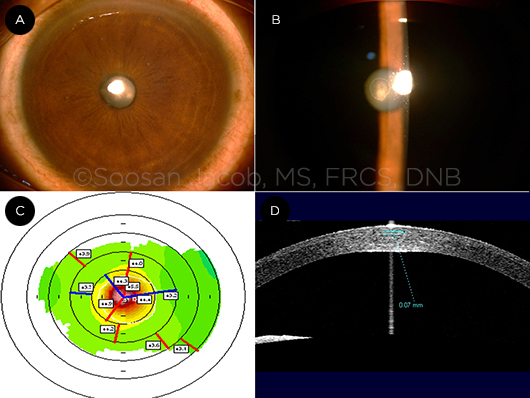Download PDF
This month, News in Review Highlights selected papers from the original papers sessions at AAO 2016. Each was chosen by the session chair because it presents important news or illustrates a trend in the field. Only 4 subspecialties are included here; papers sessions will also be held in 6 other fields. See the Meeting Program, which you’ll find in your meeting bag, or the Mobile Meeting Guide for more information.
A novel treatment for presbyopia improves binocular uncorrected near visual acuity without seriously compromising distance acuity. Called PrEsbyopic Allogenic Refractive Lenticule (PEARL), the technique was developed by Soosan Jacob, MS, FRCS, DNB. She is director and chief of Dr. Agarwal’s Refractive and Cornea Foundation, at Dr. Agarwal’s Group of Eye Hospitals in Chennai, India, where about 20 PEARL procedures have been performed.
How it works. PEARL functions as a shape-changing corneal inlay, but it makes use of a lenticule of human corneal tissue rather than artificial material. The tissue is obtained from a patient undergoing a small incision lenticule extraction (SMILE) refractive procedure for correction of –2.5 to –3.5 D of myopia, and the lenticule is implanted in the recipient’s cornea. The PEARL procedure improves depth of focus by increasing the central radius of curvature and creating an area of hyperprolateness on the cornea, surrounded by normal topography.
 |
OCT ANGIOGRAPHY. (A, B) Mild NPDR. Vessel densities (VDs) in parafoveal and perifoveal areas, respectively, were 33% and 42% in superficial plexus (A) and 20% and 29% in deep plexus (B). (C, D) Severe NPDR. VDs were 18% and 21% in superficial plexus (C) and 7% and 9% in deep plexus (D) for the respective areas.
|
Pearls for performing PEARL. “The ideal candidate for PEARL is a plano presbyope—with 20/20 uncorrected distance visual acuity—who is about 42 or 43 years old and unable to read small print (N6) on the near vision chart,” said Dr. Jacob.
The procedure involves using a femtosecond laser–dissected refractive lenticule with a diameter of 1 to 2 mm. “Over the central pupillary area of the nondominant eye, we then create a femtosecond intrastromal pocket into which we implant and center the PEARL lenticule under an inked mark,” said Dr. Jacob. “It’s important to center the lenticule on the coaxially sighted light reflex—which is the first Purkinje reflex, seen as the patient fixates coaxially.”
Benefits of PEARL. “The ease of lenticule implantation is a big plus,” said Dr. Jacob. And unlike corneal implants of synthetic materials, the lenticule is biocompatible, which allows passage of oxygen and nutrients through the cornea, prevents inflammation, and decreases the risk of corneal necrosis and melt.
A benefit of the inlay’s small size is that it allows peripheral rays to pass through the pupil. This preserves good uncorrected distance visual acuity with no loss of lines in the operated eye, while allowing the patient to perform near visual tasks.
Potential challenges and complications. Manual cutting and obtaining suitably sized lenticules are challenges of the procedure, said Dr. Jacob. “However, involving eye banks and automating steps should help overcome these problems.” Although intraoperative difficulties can include incorrect centration or trouble with implantation, she said that the procedure has been completed with ease in all cases at her center.
Because PEARL makes use of donor corneal tissue, there is potential risk of stromal rejection. However, this has not been seen in any patient thus far.
To prevent postoperative problems, patients are kept on low-dose steroids and tear supplements for 3 to 4 months, said Dr. Jacob. “With experience, it is possible that this regimen will be modified.”
| PEARL, the Presbyopic Allogenic Refractive Lenticule: A New Technique for Presbyopic Correction. When: Saturday, Oct. 15, 11:00-11:07 a.m., during the refractive surgery original papers session (10:00 a.m.-12:10 p.m.). Where: S405. Access: Free. |
Prospects for the future. Although initial results are encouraging, said Dr. Jacob, they need to be validated with a larger study and long-term follow-up. “With automated production, widespread adoption is possible,” she said, “giving this the potential to become a game changer. And, in the future, PEARL could possibly be combined with LASIK or SMILE for correction of any refractive error as well as be implanted in pseudophakic patients.”
—Annie Stuart
___________________________
Relevant financial disclosures—Dr. Jacob: None.
See the disclosure key at www.aao.org/eyenet/disclosures.
More from this month’s News in Review